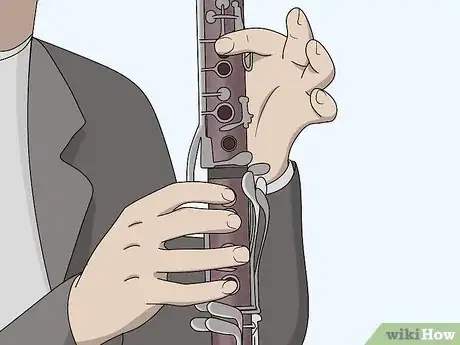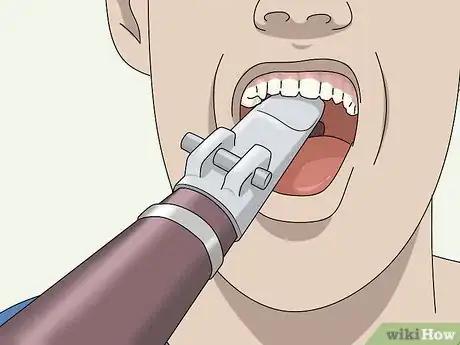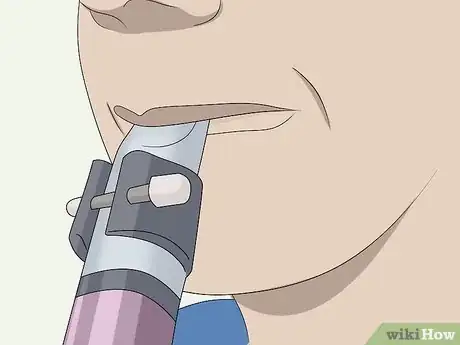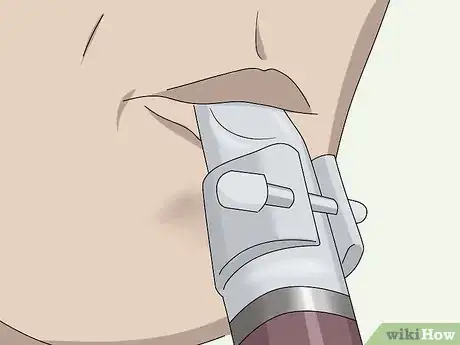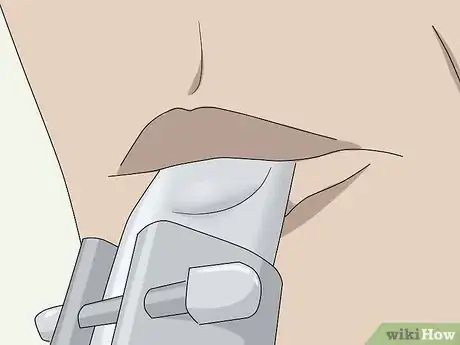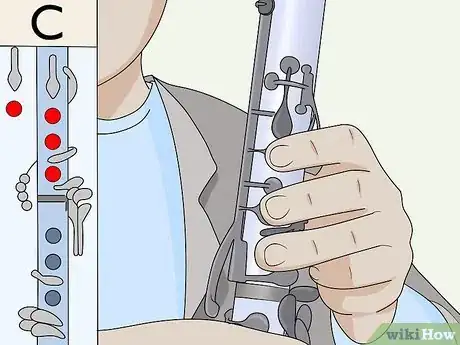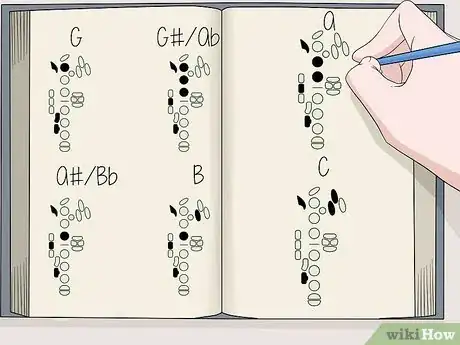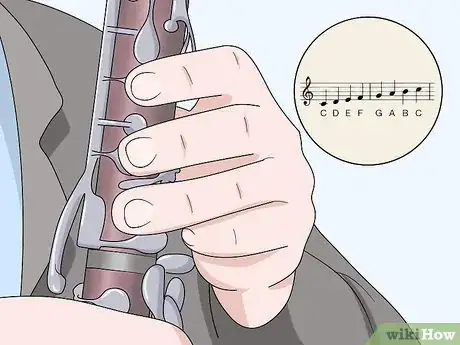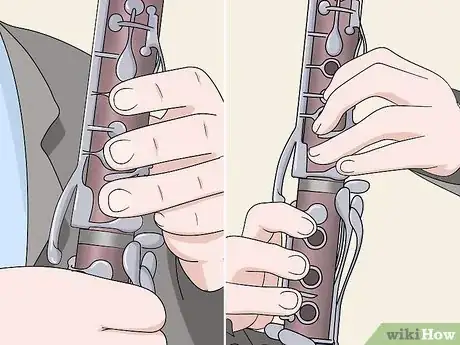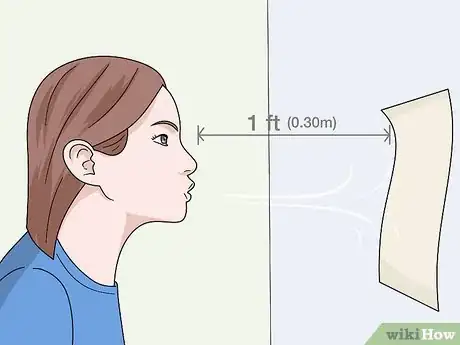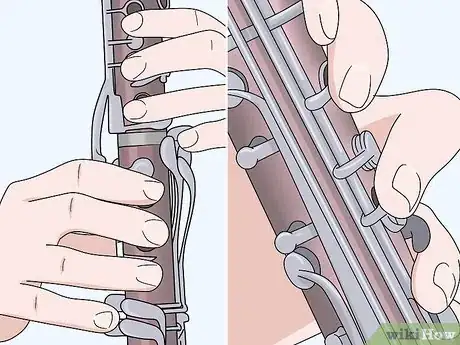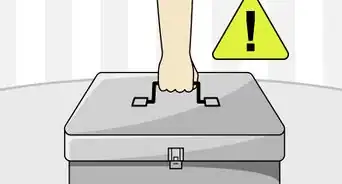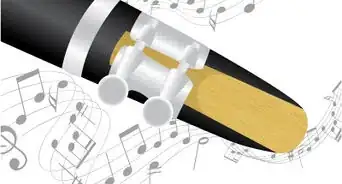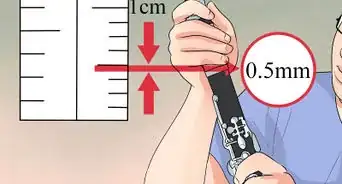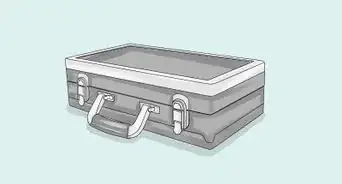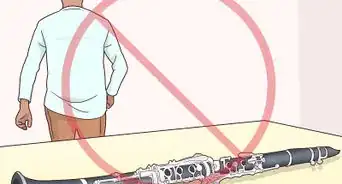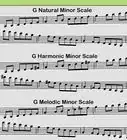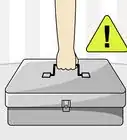This article was co-authored by wikiHow Staff. Our trained team of editors and researchers validate articles for accuracy and comprehensiveness. wikiHow's Content Management Team carefully monitors the work from our editorial staff to ensure that each article is backed by trusted research and meets our high quality standards.
There are 7 references cited in this article, which can be found at the bottom of the page.
This article has been viewed 104,187 times.
Learn more...
The altissimo notes on a clarinet are the range of high tones above and including C sharp. Learning how to play altissimo notes well on a clarinet can seem really difficult, but you can easily master the notes and produce warm and smooth high notes. The keys to playing altissimo notes are a well-formed embouchure, proper breath control and lip pressure, and lots and lots of practice.
Steps
Forming a Good Embouchure
-
1Hold your clarinet and place the pads of your fingers on the ring keys. Place the fingers of your left hand over the tops of the holes on the upper joint of the clarinet. Then, take your right hand and place your fingers over the tops of the holes on the bottom joint. Set your right thumb under the hook on the bottom joint to help you hold the clarinet.[1]
- Use the pads of your fingers, not your fingertips.
- Hold the clarinet at a slight angle from your body.
Tip: Allow the bell, or the end of the clarinet, to be pointed out slightly to make holding the clarinet more comfortable.
-
2Set your upper teeth on the top of the mouthpiece. Keep the clarinet pointed down and place the mouthpiece into your mouth slightly to allow your teeth to rest against the top of the mouthpiece.[2]Advertisement
-
3Place your lower lip slightly over your lower teeth. Still keeping the mouthpiece of the clarinet just slightly in your mouth, raise your lower lip so that it meets the bottom of the mouthpiece and covers your lower teeth.[3]
- Extend your chin slightly to help your bottom lip better connect with the mouthpiece.
- Your bottom lip will touch the reed in the mouthpiece of the clarinet.
-
4Wrap your lips around the mouthpiece to form a firm seal. After you’ve formed a good fit with your upper teeth and lower lip, bring the rest of your lips in to form a seal around the mouthpiece. Tighten your lips to make them firm and make the seal strong.[4]
- Your lips should be tight but still comfortable.
-
5Keep your lips taut while you open your mouth slightly. Once you’ve formed a strong seal with your lips, keep them tight and open your mouth slightly by lowering your bottom jaw just a bit to allow better control of the flow of air into the mouthpiece.[5]
- Don’t bite down on the mouthpiece with your teeth.
Tuning into the Altissimo Range
-
1Place about 1⁄2 inch (1.3 cm) of the mouthpiece in your mouth. To make playing the higher altissimo notes easier, place less of the mouthpiece in your mouth when you form your embouchure.[6]
- If you hear a squeak when you try to play altissimo notes, you’ll know that you have too much of the mouthpiece in your mouth.
-
2Start by playing a high C note. A high C is a good starting point when you’re learning to play altissimo notes. Cover the top holes on the upper and lower joints. Keep the thumb and register key down, or the key on the backside of the clarinet near your thumb. Then keep the pinky key down to form a high C note.[7]
- Play the high C note until you can hold a consistent tone for at least 5 seconds without any squeaking.
-
3Blow a fast stream of steady air from your belly. In order to produce a steady, even tone, you need to push air into the mouthpiece quickly. Push the air from your diaphragm to produce a breath strong enough to play the clarinet.[8]
- A weak stream of air will produce a dull, low note.
- If you blow too hard or forcefully, your clarinet will produce a squeaky sound.
-
4Play long tones to find the altissimo notes. The only way to become better at producing altissimo notes is to play long tones. When you find the note, hold it for at least 4 counts of a beat, or at least 5 seconds.[9]
Tip: It can take a long time to master playing altissimo notes without high-pitched abrasive squeaks. Find a secluded place to practice far out of earshot of anyone.
-
5Move up the scale 1 half step at a time. When you feel comfortable playing a high C note, try playing a C sharp by raising the index finger of your left hand that covers the E note. From there, you can try moving to a D note by raising your finger covering the F note. Play one note until you can confidently and consistently play a long tone of the altissimo note.[10]
- If you’re a beginner, make sure you can play the notes approaching high C consistently before trying to play higher notes.
Practicing with Different Fingerings
-
1Get a fingering chart and work on identifying the notes on the music ledger. Use a fingering chart that has several fingering suggestions for each note in the altissimo range. As you practice playing in the altissimo range and using different fingerings, make sure you also practice note identification.[11]
- The many lines on the ledger can be difficult to interpret at first, but it’s important to know what notes they’re referring to as you play.
- A few good fingering charts are: Ridenour’s Clarinet Fingerings and Opperman’s The New Extended Working Range.
-
2Write down your favorite altissimo fingerings in a notebook. Make your own altissimo fingering chart as you practice different fingerings so you don’t forget any of them. If you find or create a fingering that works well for you, write it down and keep notes next to the fingerings you play.[12]
- For example, if a particular fingering is good for a sharper sound, make a note next to it in your notebook.
- Add any suggestions that your teachers or friends give you about a fingering.
-
3Practice all of the octaves of each note. You can check if the high note that you’re playing is the correct note by playing a note that is an octave lower to see if the pitch matches it. Work to match the tuning, pitch, and timbre. Practicing the octaves will help with your technique.[13]
- Play familiar sections of a repertoire and tune the notes all the way up an octave to reach the highest note.
Tip: Use a tuner to help make sure that the octaves match.
-
4Try playing the “squeaking exercise.” You can practice the altissimo notes and learn about the overtone series of the clarinet by beginning on a low C note, then “squeaking” your way up the partials of the clarinet. Work to make the transition smoother and less squeaky.[14]
- Practice adjusting your air and embouchure to produce the upper partials rather than relying on your register key.
-
5Try a variety of notes and fingerings. As you practice playing the altissimo notes, you’ll find that some fingerings work better for ascending intervals and others work better for descending. Arm yourself with many different fingerings so when you learn new music, you’ll be able to determine which fingering will work best in each circumstance.[15]
- There are multiple fingerings for the same high note. If one fingering isn’t producing a smooth and consistent tone, then try another.
Troubleshooting Your Technique
-
1Avoid pinching your lip and biting down on the mouthpiece. Many clarinet players, especially beginners, think that pinching your lips and biting down on the mouthpiece to tighten it will improve their ability to reach a high note. But doing so will often result in cutting off the sound of the clarinet completely.[16]
- You could also crack or warp the reed.
-
2Test your air speed with a piece of paper. Take a sheet of paper and stand about 1 foot (0.30 m) away from a wall. Use just your breath to hold the paper against the wall for at least 3 seconds. If the paper immediately falls to the ground, then you’re not using enough air or the air isn’t fast enough.[17]
Tip: Try forming your mouth into your embouchure when you blow the paper against the wall to simulate blowing into the mouthpiece of your clarinet.
-
3Double-check your fingering to make sure it’s correct. Make sure all of your fingers are covering the tone holes entirely and that you’re using the pads of your fingers, not your fingertips. Remember to add the pinky key on your right hand as well.[18]
- Try a different fingering to see if it works better.
Community Q&A
-
QuestionHow do I play the 3rd octave?
 Community AnswerMake sure you use a correct embouchure. Tighten the sides of your lips and flatten your chin. Raise your eyebrows and use more air than you think you should. If you are becoming red and not able to play the notes without feeling like you are going to run out of air, take more reed into your mouth. The main reason most people have a hard time with the 3rd octave is because of their embouchure, so try practicing the high G, A, B, and C as well and then transitioning to the 3rd octave. Also, the harder the reed, the easier it is going to be to play the higher notes. I recommend at least a 2 1/2, but the harder the better. Lastly, practice is the key!
Community AnswerMake sure you use a correct embouchure. Tighten the sides of your lips and flatten your chin. Raise your eyebrows and use more air than you think you should. If you are becoming red and not able to play the notes without feeling like you are going to run out of air, take more reed into your mouth. The main reason most people have a hard time with the 3rd octave is because of their embouchure, so try practicing the high G, A, B, and C as well and then transitioning to the 3rd octave. Also, the harder the reed, the easier it is going to be to play the higher notes. I recommend at least a 2 1/2, but the harder the better. Lastly, practice is the key! -
QuestionHow do I hold my mouth on the clarinet?
 StefaniaCommunity AnswerYou should make your embouchere the same as if you were playing regular notes, except you should tuck your tummy in more.
StefaniaCommunity AnswerYou should make your embouchere the same as if you were playing regular notes, except you should tuck your tummy in more.
References
- ↑ http://www.clarinet-now.com/clarinet-right-hand-position.html
- ↑ http://www.clarinet-now.com/clarinet-embouchure.html
- ↑ http://thevault.musicarts.com/how-to-get-the-best-sound-on-the-clarinet/
- ↑ https://owd.tcnj.edu/~mckinney/clarinet_embouchure.htm
- ↑ http://www.clarinet-now.com/clarinet-embouchure.html
- ↑ https://www.clarinetcloset.com/clarinet-altissimo.html
- ↑ http://jennyclarinet.com/2018/06/the-complete-guide-to-the-clarinet-altissimo-register/
- ↑ http://www.clarinet-now.com/clarinet-embouchure.html
- ↑ https://www.clarinetcloset.com/clarinet-altissimo.html
- ↑ http://jennyclarinet.com/2018/06/the-complete-guide-to-the-clarinet-altissimo-register/
- ↑ http://jennyclarinet.com/2018/06/the-complete-guide-to-the-clarinet-altissimo-register/
- ↑ http://jennyclarinet.com/2018/06/the-complete-guide-to-the-clarinet-altissimo-register/
- ↑ https://nafme.org/mystery-clarinet-high-notes-part-2/
- ↑ https://nafme.org/mystery-clarinet-high-notes-part-2/
- ↑ http://jennyclarinet.com/2018/06/the-complete-guide-to-the-clarinet-altissimo-register/
- ↑ http://www.clarinet-now.com/clarinet-embouchure.html
- ↑ http://jennyclarinet.com/2018/06/the-complete-guide-to-the-clarinet-altissimo-register/
- ↑ http://jennyclarinet.com/2018/06/the-complete-guide-to-the-clarinet-altissimo-register/
